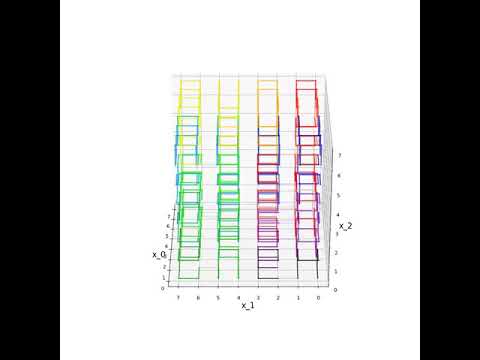Construct Hilbert Curves.
Project description
Introduction
This is a package to convert between one dimensional distance along a Hilbert curve, h, and N-dimensional coordinates, (x_0, x_1, ... x_N-1). There are two important parameters,
N – the number of dimensions (must be > 0)
p – the number of iterations used in constructing the Hilbert curve (must be > 0)
We consider an N-dimensional hypercube of side length 2^p. This hypercube contains 2^{N p} unit hypercubes (2^p along each dimension). The number of unit hypercubes determine the possible discrete distances along the Hilbert curve (indexed from 0 to 2^{N p} - 1).
Quickstart
Install the package with pip,
pip install hilbertcurveYou can calculate coordinates given distances along a hilbert curve,
>>> from hilbertcurve.hilbertcurve import HilbertCurve
>>> p=1; N=2
>>> hilbert_curve = HilbertCurve(p, N)
>>> for ii in range(4):
>>> coords = hilbert_curve.coordinates_from_distance(ii)
>>> print(f'coords(h={ii}) = {coords}')
coords(h=0) = [0, 0]
coords(h=1) = [0, 1]
coords(h=2) = [1, 1]
coords(h=3) = [1, 0]You can also calculate distances along a hilbert curve given coordinates,
>>> for coords in [[0,0], [0,1], [1,1], [1,0]]:
>>> dist = hilbert_curve.distance_from_coordinates(coords)
>>> print(f'distance(x={coords}) = {dist}')
distance(x=[0, 0]) = 0
distance(x=[0, 1]) = 1
distance(x=[1, 1]) = 2
distance(x=[1, 0]) = 3(Absurdly) Large Integers
Due to the magic of arbitrarily large integers in Python, these calculations can be done with … well … arbitrarily large integers!
>>> p = 512; N = 10
>>> hilbert_curve = HilbertCurve(p, N)
>>> ii = 123456789101112131415161718192021222324252627282930
>>> coords = hilbert_curve.coordinates_from_distance(ii)
>>> print(f'coords = {coords}')
coords = [121075, 67332, 67326, 108879, 26637, 43346, 23848, 1551, 68130, 84004]The calculations above represent the 512th iteration of the Hilbert curve in 10 dimensions. The maximum value along any coordinate axis is an integer with 155 digits and the maximum distance along the curve is an integer with 1542 digits. For comparison, an estimate of the number of atoms in the observable universe is 10^{82} (i.e. an integer with 83 digits).
Visuals

The figure above shows the first three iterations of the Hilbert curve in two (N=2) dimensions. The p=1 iteration is shown in red, p=2 in blue, and p=3 in black. For the p=3 iteration, distances, h, along the curve are labeled from 0 to 63 (i.e. from 0 to 2^{N p}-1). This package provides methods to translate between N-dimensional coordinates and one dimensional distance. For example, between (x_0=4, x_1=6) and h=36. Note that the p=1 and p=2 iterations have been scaled and translated to the coordinate system of the p=3 iteration.
An animation of the same case in 3-D is available on YouTube. To watch the video, click the link below. Once the YouTube video loads, you can right click on it and turn “Loop” on to watch the curve rotate continuously.

3-D Hilbert Curve Animation https://www.youtube.com/watch?v=TfJEJidwkBQ
Reference
This module is based on the C code provided in the 2004 article “Programming the Hilbert Curve” by John Skilling,
I was also helped by the discussion in the following stackoverflow post,
which points out a typo in the source code of the paper. The Skilling code provides two functions TransposetoAxes and AxestoTranspose. In this case, Transpose refers to a specific packing of the integer that represents distance along the Hilbert curve (see below for details) and Axes refer to the N-dimensional coordinates. Below is an excerpt from the documentation of Skilling’s code,
//+++++++++++++++++++++++++++ PUBLIC-DOMAIN SOFTWARE ++++++++++++++++++++++++++ // Functions: TransposetoAxes AxestoTranspose // Purpose: Transform in-place between Hilbert transpose and geometrical axes // Example: b=5 bits for each of n=3 coordinates. // 15-bit Hilbert integer = A B C D E F G H I J K L M N O is stored // as its Transpose // X[0] = A D G J M X[2]| // X[1] = B E H K N <-------> | /X[1] // X[2] = C F I L O axes |/ // high low 0------ X[0] // Axes are stored conveniently as b-bit integers. // Author: John Skilling 20 Apr 2001 to 11 Oct 2003
Project details
Release history Release notifications | RSS feed
Download files
Download the file for your platform. If you're not sure which to choose, learn more about installing packages.
Source Distribution
File details
Details for the file hilbertcurve-1.0.3.tar.gz.
File metadata
- Download URL: hilbertcurve-1.0.3.tar.gz
- Upload date:
- Size: 6.4 kB
- Tags: Source
- Uploaded using Trusted Publishing? No
- Uploaded via: twine/3.1.1 pkginfo/1.5.0.1 requests/2.22.0 setuptools/42.0.1 requests-toolbelt/0.9.1 tqdm/4.32.1 CPython/3.7.3
File hashes
| Algorithm | Hash digest | |
|---|---|---|
| SHA256 |
cb041f40f1b26843ef093d104954c55cf0dba5b6e976371a510432c193ee951d
|
|
| MD5 |
9eba2c5c369abee80d54095071033418
|
|
| BLAKE2b-256 |
896f25919200d8b3851321738e5e72ff370db3fd7f0d6c13748997aab34d3f80
|










